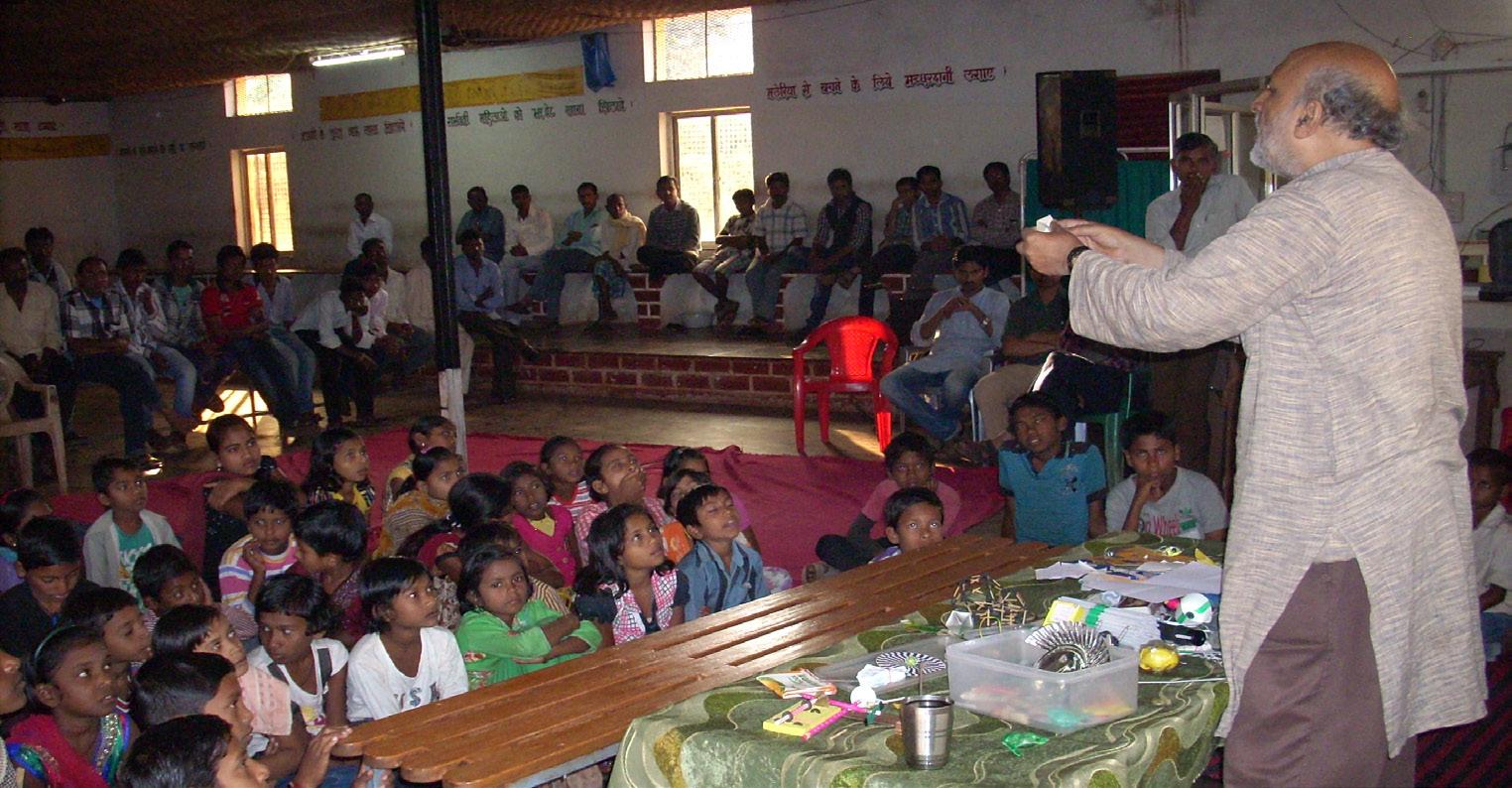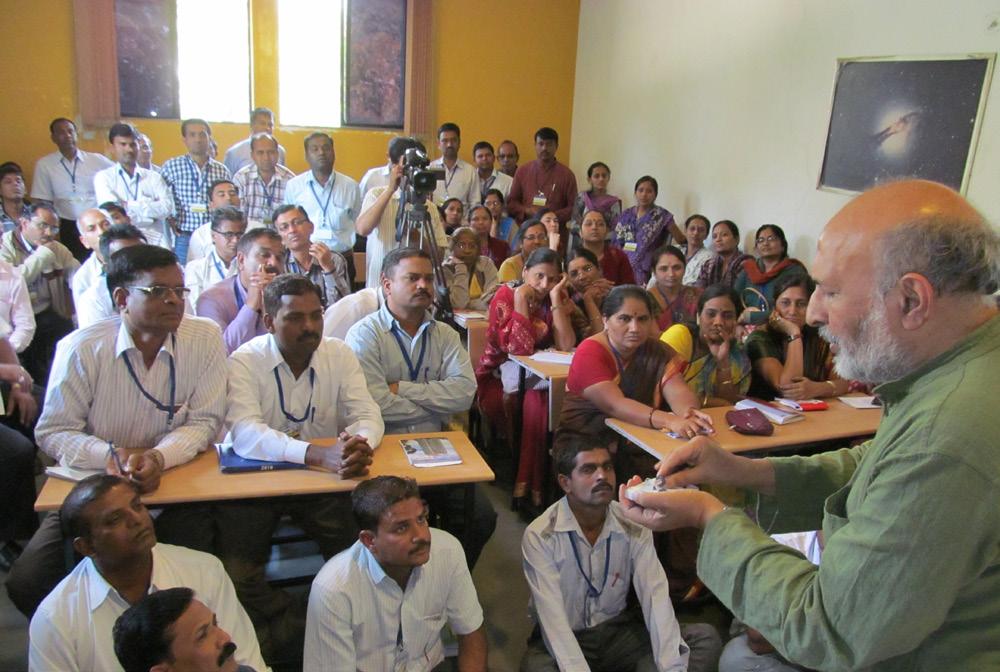
9 minute read
A Magical Science Teacher, the greatest Toy Maker, Padma Shree, Shri Arvind Gupta- Special Interview
by Community News Editor (Australia India News), Amrita Deshpande.
Shri Arvind Gupta is a wellknown and most loved science teacher among children not only in India but also internationally. He is a nationally and internationally recognised educator. He is an engineer by profession but took up the mammoth task of using trash to convert it into toys which he could use as aids to teach children concepts in science. It has been about 50 yrs that he is relentlessly working in this field. He is challenging and developing the malleable brains of India’s young aspiring scientists through his toy making workshops. He is an explorer and traveler who has also visited Australia and taught workshops in schools in Canberra. In 2018 he was awarded Padmashri for his work in science communication. He is also recognised by UNESCO, UNICEF, MIT Media Lab, International Toy Research teachers of several developing countries. Universities like the Halmstad University, Boston Science Centre, have acknowledged his work and his books. Walt Disney Imagineering and Research, Auhof Rehabilitation Centre, Hilpolstien, Germany and the International Play Association, Finland are organisations who have recognised his designs for teaching aids. IIT Kanpur has recognised him as a distinguished alumnus. Several Indian local organisations have recognised him and his books on science teaching aids.

Community News Editor, Ms Amrita Deshpande interviewed Shri Arvind Gupta about his work as an educator, and his journey as aToy maker.

Following is the interview.
Amrita: You have been in the profession of teaching children through experiments and toys for almost 50 yrs, what was the moment, when you first felt this is it, this is what I should do?

Shri Arvind Gupta: In 1972, as a second-year student, I first heard of Dr. Anil Sadgopal a PhD from Caltech who started the grassroots program “the Hoshangabad Science Teaching Program (HSTP)”. The HSTP aimed at making science fun for village children, using simple, local, low-cost materials and turning them into science activities. Later the HSTP spread to over 1000 schools. In 1978, as a young engineer working in a truck plant in Pune, I took a year’s leave to work with the HSTP. During my first month I designed the Matchstick Meccano using matchsticks and pieces of rubber cycle valve tube as joints. This made me very happy. That was the first time I felt I could use my engineering background for a larger social good.

Amrita: When one says Arvind Gupta it has now become synonymous with "toy maker”, if you could elaborate on why and what inspired you to experiment, create and teach children through these toys?
Shri Arvind Gupta: While designing low-cost science experiments I stumbled across a book by Sudarshan Khanna titled DYNAMIC FOLK TOYS. It was a documentation of India’s finest traditional toys which often used recycled materials. They were aesthetic, low-cost and accessible to the poorest. Inspired by it I tried to use modern day junk - plastic bottles, Tetra Pak, old newspapers etc into making toys. We have over 100 experiments using old plastic bottles. Also 60 toys made with Tetra Pak. We also fold newspapers to make 20 different caps which children can wear.
Amrita: Science as a subject often is difficult to learn for children unless they see for themselves what happens when a chemical reaction happens or what is pressure, force etc. Tell us about your experiences with children, how do they react to the demonstrations and workshops?
Shri Arvind Gupta: Unfortunately, children in Indian schools get little exposure to science experiments. Mostly science is learnt by rote. In the best school with an active science lab the teacher might simply demonstrate. But children seldom get an opportunity to handle science equipment. Our toughest exams, the JEE (entrance to IITs) and NEET (entrance to Medical Colleges) are based on ticking the right box in multiple choice questions. There is little emphasis on working with the hands or relating science to real life.
So, when children see working science models out of everyday materials they are enthralled. They feel empowered. They feel that they too can make them.
Amrita: I know you have tons of books, YouTube videos and films to your name, how has that journey been for you from engaging children via books, vs engaging via YouTube channel videos?
Shri Arvind Gupta: The opportunity to share came about in 2003 when I was invited by Prof. Jayant Narlikar – India’s most distinguished astrophysics to work at the children’s science centre of IUCAA (Inter University Centre for Astronomy & Astrophysics) located in the Pune University. We had a very passionate young team of three people. We documented over 1100 toys and science activities in 2-minute videos. Today we have 8700 videos on You tube in 15 languages. We have 300 videos in Spanish. They have been viewed by over 100 million children worldwide. We have made available thousands of books in Indian languages. Everyday 7000 books are downloaded from my website: arvindguptatoys.com
Amrita: You have met Nobel laureates, eminent people. Do you have a story to tell in that regard vis a vis your passion for science and toy making, teaching tribal children?
Shri Arvind Gupta: One common trait in most eminent people islove for their own roots. You can see that in Rabindranath Tagore and Gandhi. Unless you love your own roots deeply, it is unlikely that you will work for change. Often there is much to learn from tribal children. They know their forests and habitats inside out –they know each local plant and tree and their uses. Unlike urban children they have a deep and rich knowledge of their surroundings. Before we suggest any solution, we need to first learn from the people. Ultimately, the people should be part of the solution. Then only will it work.
Amrita: What has your experience been in terms of teaching children in villages, vs teaching Children in cities?
Shri Arvind Gupta: The village kids have fewer distractions as compared to the children in the city. They have less electronic devices, toys etc. So, their concentration is much more. In most of the hands-on workshops we find village kids do things better and faster with their hands as compared to city kids.
Amrita: You have been recognised by UNESCO, UNICEF, MIT Media Lab and International Toy Research teachers of several developing countries. Any stories to tell about that?
Shri Arvind Gupta: I was privileged to have worked in 25 countries. A few years back I was invited to Australia by a company called Hotel-Hotel. This seven-star hospitality company is deep into sustainability. So, they wanted to feature Toys from Trash, as an alternative to factory-made mass-produced toys. I went to Australia for 15 days - first a week in Canberra with Hotel-Hotel. They featured some workshops in their Hotel itself. The rest of the days I was sent to demonstrate my toys in several schools - some were old established Ivy League schools, but some were small progressive schools (I liked them very much).
After having visited many science centres in several countries, I realized that we must learn from their experiences but create something different, something which is much more relevant to our conditions in India. Children learn best not by seeing or listening, but by making things with their own hands. This is what we latched on.
Amrita: The current Education system in India, do you think it has changed now to accommodate teaching and learning in a non-formal way?
Shri Arvind Gupta: Yes, there has been a distinct shift from rote learning to activity-based learning.
Today the NCERT and the SCERTs talk about learning through projects and activities. But there is a great shortage of practitioners of this craft. We need to inspire a new breed of teachers to make hands-on activities mainstream.
Despite all the good initiatives the state of education in India remains quite dismal. We have many good private schools comparable to some of the best in the world but very poor public schools. The educational terrain is quite barren and stony. Even a good seed will wilt because of lack of nurturance. As civil society our small task is to everyday create a fistful of soil. Without soil there will be no flowers, no spring harvest. We must endeavour to collectively create that soil.
Amrita: Talking of Indian teachers, what would you tell teachers today, how should they equip themselves when teaching science in school?
Shri Arvind Gupta: I have visited over 3000 schools and when I see their science labs, I find the cupboards locked. Most teachers and management are afraid that children will break burettes and test tubes, so they keep them locked. They forget that the most precious thing in the lab is not the fancy glassware and plasticware, but it is the children’s mind.
I would tell teachers that most of the science experiments until class 10th can be improvised with simple very low-cost materials. You don’t have to be rich or an elite school to do science experiments. More important is the political will. Even if something breaks it is not the end of the world. Let the children do hands-on activities using simple readily available materials. Yes, you have to buy magnets, copper wire, straws and sundry other stuff. We have coined an anarchistic slogan: THE BEST THING A CHILD CAN DO WITH A TOY IS TO BREAK IT.
Amrita: Having got Padmashree and other awards, and recognition, is there something you feel that “I still need to do”?
Shri Arvind Gupta: I have an abiding interest in children, which keeps me busy and going. The awards are incidental and welcome because they give the work a certain visibility and legitimacy.
I feel nice that our work has reached out to so many. But in a large country like India, we need to do much more especially in the regional languages and the Hindi speaking states where the Human Development Index is very low.
I come from Uttar Pradesh, from the Hindi heartland. There is great poverty and lack of good children’s books in Hindi, even greater shortage of good books on Education. So, I keep translating children’s books in Hindi and motivating others to do the same in Hindi, Marathi and other Indian languages. That is something that we need to promote among our younger generation to take up as a career. We need translators for translating books in Hindi. Shri Arvind Gupta has many books and videos compiled on how to make toys for teaching as well as for children to experiment. Please check his youtube channel for videos. https://www.youtube.com/@ arvindguptatoys/about










